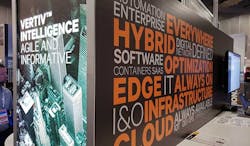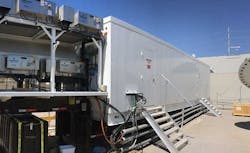Vertiv Builds for the Future, With A Focus on Edge Computing
Edge computing may be in the early stages of development. But it’s not just startups and mobile networks that are positioning themselves for the edge computing disruption.
A prime example is Vertiv, a multi-billion dollar company backed by experienced players in the private equity world. Vertiv was created in 2016 by Platinum Equity Group, which acquired the Emerson Network Power business from Emerson in a $4 billion transaction. The company brings together many storied brands in the data center realm, most notably the powerhouse Liebert line of power and cooling products, along with Chloride and NetSure.
Two years after it was spun out of Emerson, Vertiv is focused on the edge computing opportunity, and retooling for a more agile data center landscape. It’s an effort that has involved extensive study of the emerging market, and how customers will use edge services. The resulting “archetypes” are guiding Vertiv’s edge strategy.
“We want to lead and take the confusion out of it,” said Rob Johnson, the CEO of Vertiv. “We don’t look at edge as pieces and parts, but as an entire solution. We think about it holistically, from the rack through thermal management and security.”
Platinum brought in Johnson, a partner in private equity firm Kleiner Perkins, to lead Vertiv into that future. Johnson is well known in the data center industry from his tenure as President and CEO of American Power Conversion, which for many years was the primary rival for Emerson Network Power in the power and cooling market.
Investing in Transformation
Johnson says Vertiv is in the midst of two key transitions. The first is the transition from life as a unit of a large publicly-held conglomerate to an independent, more nimble private company. The second is the shift from the world of legacy data centers and telecom to a world dominated by cloud – and soon, edge computing.
“The focus was to take a good brand with great products, and focus it on the customer and staying true to the data center market,” said Johnson. “We expected it would be a 24- to 36-month process, and the transition is going well. The business had been in decline, and now it is growing nicely, and we’re taking share (from competitors).”
ROB JOHNSON, CEO of Vertiv
Vertiv is now a company of 20,000 employees across the globe and 2017 revenue of $3.9 billion. Its largest business lines are in power and thermal management, with an active services business, and a growing software solutions unit.
Johnson says Platinum Equity has invested “several hundred million” dollars in Vertiv as it restructures to align with a changing environment, including a bigger emphasis on supporting large, fast-moving colocation and cloud players, and the emerging opportunity in edge computing.
“Change for any big company is difficult,” said Johnson. “I think we’ve made ourselves very relevant with the cloud players in terms of doing business the way they want to do business.”
That means embracing a more flexible and agile product development process, according to John Hewitt, President of Vertiv in the Americas.
“It’s a mindset shift,” said Hewitt. “We’re effectively trying to complete a five- to seven-year transformation in a two- to three-year time frame. The most important reason is that our customers are demanding it.”
Navigating the Edge Confusion
That customer-centric mentality is visible in Vertiv’s approach to edge computing, a sector muddled by confusion over dueling definitions, with various parties quantifying it by technology, topology or form factor. Seeking to apply an end user lens, Vertiv spent more than a year developing an overview of edge use cases, summarized in a report (Edge Archetypes) that outlines its take on the layers of edge architecture.
The four edge archetypes – use cases – defined by Vertiv. (Image: Vertiv)
“Edge Archetypes was an effort to simplify things and help develop a roadmap,” said Martin Olsen, Vice President, Global Edge and Integrated Solutions. “We have a lot of great technologies, and a lot of it is being able to put things together.”
That’s where the Vertiv team believes the breadth of its offerings is a good fit with edge requirements.
“It’s making sure we have the right end-to-end solutions,” said Hewitt. “There’s not a lot of standards yet. We’re trying to get our company and products aligned with where the edge is headed. Sometimes it’s a custom solution for a specific customer, or it could be a retailer that needs 3,500 locations. We’ve got to be very, very flexible.”
An overview from Vertiv of the layers of edge computing infrastructure. Click for a larger version. (Source: Vertiv)
“Virtually every aspect of business and society is starting to rely on edge computing to improve quality of life and become more connected and competitive,” said Hewitt. “For our customers – and their customers – continuity of compute and service is crucial.
“Innovation in the edge space means addressing availability challenges with quickly deployed, scalable infrastructure, and lifecycle services that make edge compute sustainable for IT resources that are already stretching to meet SLAs,” Hewitt added.
Preparing for A Lights-Out World
A key challenge is being able to adapt to the evolution of edge computing, which is still sorting out its business models. One early use case will be 5G wireless, which also plays to some of Vertiv’s historic strengths with carriers and mobile operators.
“We’re a little unique in that 25 percent of our business is in the telecom space and DC power, which is a very small world,” said Patrick Quirk, Vice President and General Manager of Management Systems for Vertiv. “Our unique advantage has been to see the carrier trends. Ease of deployment will be a critical factor for edge – simplicity across all the building blocks to the commissioning and deployment.”
An example of an edge computing deployment for a Vertiv customer. (Photo: Vertiv)
Many edge facilities will be “lights out” – unmanned shelters or data center modules that require remote management. “There’s the potential for a transformation in monitoring,” said Quirk.
To that end, last month Vertiv introduced vIntelligence, a cloud-based management platform offering analytics and management for IT infrastructure, which can tie togther assets from hyperscale facilities and those at the edge of the network.
“We are uniquely positioned to deliver these capabilities because of the depth and breadth of our experience in this space,” Quirk said. “Vertiv has a long history of innovation in monitoring and management solutions for critical infrastructure systems. Vertiv Intelligence brings that level of insight to the palm of your hand, allowing users to choose exactly what kind of information they receive, how and when they receive it, and what actions should be executed as a result.”
Olsen believes the archetypes will be a useful guide for Vertiv’s business and its customers.
“We believe most of the use cases are pretty real,” said Olsen. “We need certain reference designs, which will evolve. We have focused our efforts on what we’re really good at and projecting a little about how that evolves. We believe smaller systems will be a part of that.”
Opportunity in the Cloud Supply Chain
Beyond the edge, Johnson is focused on having Vertiv play a larger role in the wholesale colocation sector, where large deals are coming to represent a growing chunk of industry activity. He acknowledges that the large equipment vendors in the data center industry had trouble keeping pace with the needs of the largest hyperscale providers, who opted to design their own customer hardware.
“Ten years ago, hyperscale guys were innovating everything,” said Johnson. “We created the problem with hyperscale.”
But as the hyperscale market matures, Johnson says, it is transitioning away from “snowflake” designs to a supply chain. “Over the last two years, this has been shifting to more normalized, modular deployments with speed-to-market and repeatable knowledge. The market has moved from everyone wanting to do their own thing to having standards and more work done in the factory. You’ll see more from us on standardized products.”
“Vertiv will pride itself on innovation in this space and solving real problems. We’re not just power and cooling.”
Vertiv CEO Rob Johnson
Johnson says Vertiv is on track in its mission to transform its organization and capabilities.
“Vertiv will pride itself on innovation in this space and solving real problems,” said the CEO “We’re not just power and cooling. We can provide a single stand-alone rack with monitoring and security, as well as hyperscale megacenters. I think our work on edge helps people understand us and position us differently.
“It takes a while,” said Johnson. “We think we’re making progress globally, but we still have work to do.”
About the Author




